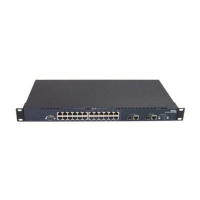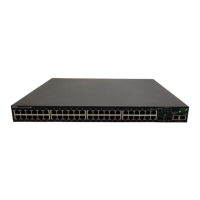BigIron RX Series Configuration Guide 351
53-1002253-01
SuperSpan™
12
In the above example, STP in VLAN 10 will select R10 as the root bridge and make 1/1 on R10
forwarding while blocking port 3/1 on R20. The opposite occurs for STP in VLAN 20. As a result,
both links connecting the customer and SP regions are fully utilized and serve as backup links at
the same time, providing loop-free, non-blocking connectivity. In the SP network, multiple STP
instances are running (one for VLAN 100 and one for VLAN 200) to ensure loop-free, non-blocking
connectivity in each VLAN.
SuperSPAN boundaries are configured at port 2/1 of R100 and R200. Since the customer’s traffic
will be aggregated into VLAN 100 at the SP, the SP network appears to the customer to be a
loop-free non-blocking hub to the customer network when port 2/2 on R200 is blocked by STP in
VLAN 100.
Customer uses multiple spanning trees but SP uses single STP
Figure 37 shows an example of SuperSpan where the customer network uses multiple spanning
trees while the SP network uses Single STP.
FIGURE 37 Customer using Multiple Spanning Trees and SP using single STP
Customer traffic from different VLANs is maintained by different spanning trees, while the SP
network is maintained by a single spanning tree. The SP can still use multiple VLANs at the core to
separate traffic from different customers. However, all VLANs will have the same network topology
because they are all calculated by the single spanning tree. The loop-free, non-blocking network
acts like a hub for the customer network, with boundary ports 2/1 on each device being untagged
members of VLAN 100.
Traffic from all VLANs in the customer network will be aggregated through VLAN 100 at the SP. This
setup leaves the customer network’s switching pattern virtually unchanged from the scenario in
“Customer and SP use multiple spanning trees” on page 350, since the SP network still is
perceived as a virtual hub, and maintenance of the hub's loop-free topology is transparent to the
customer network.
tagged to multiple vlan
stp-boundary
untagged to vlan 100 (Super Aggregated VLAN)
Customer
Region
Provider
Region
Root bridge for VLAN xx
1/1
2/1
2/2
3/1
2/1
2/2
R
R
10
R
20
R xx
single
span

